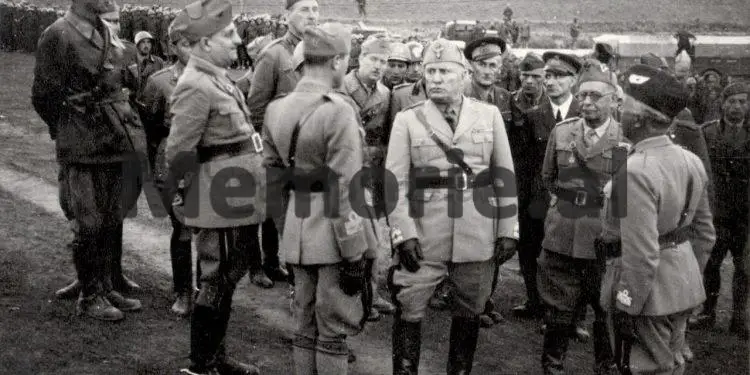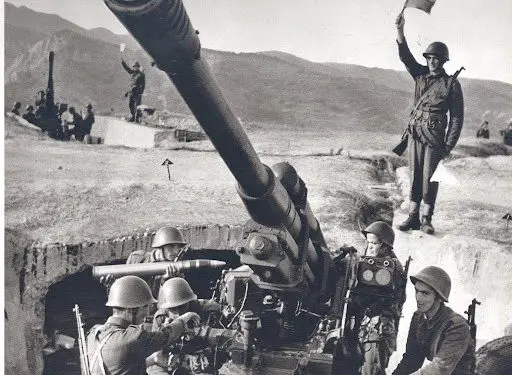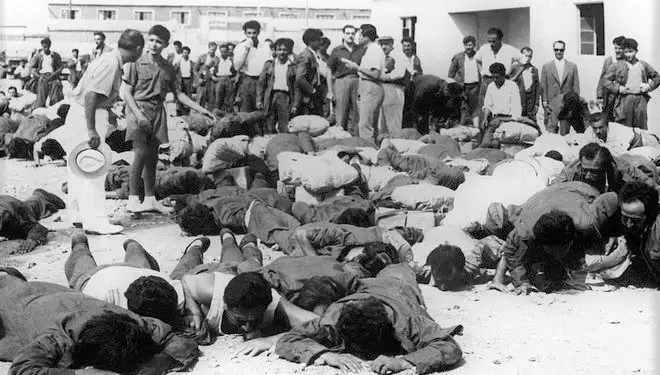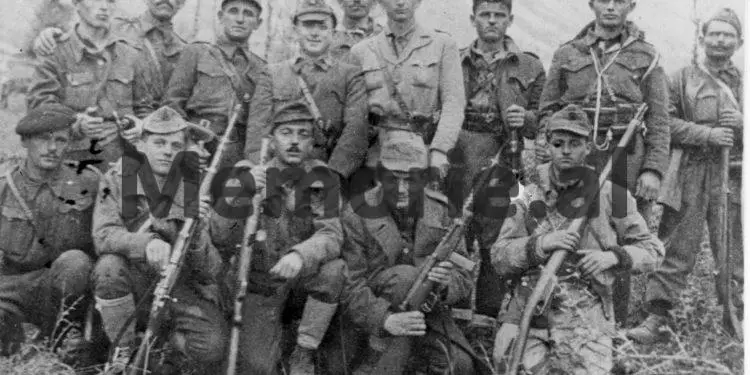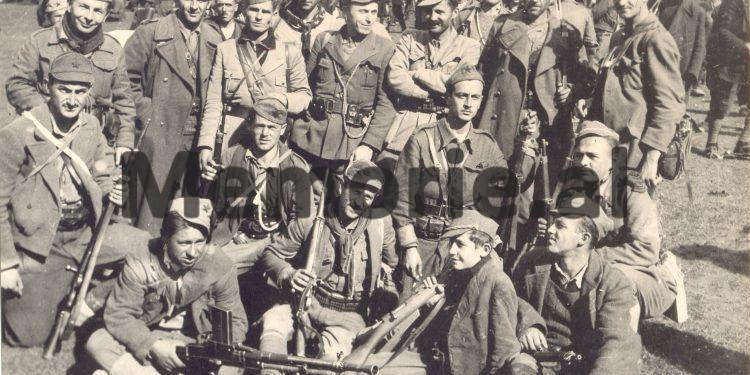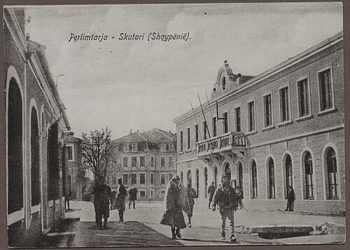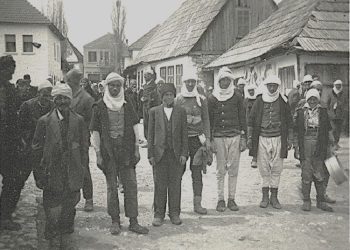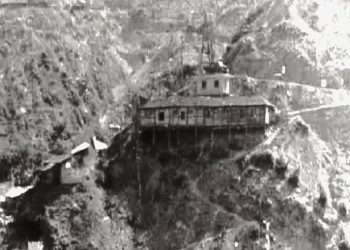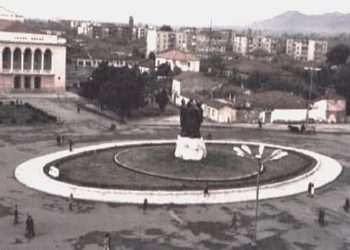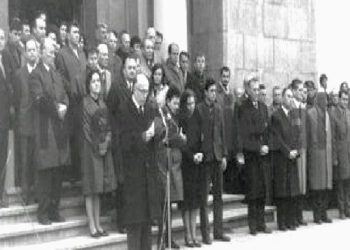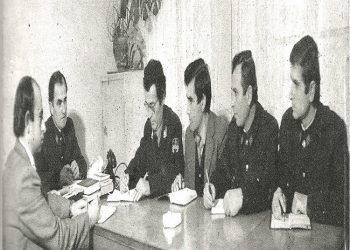By Lieutenant Colonel Jorgo Qirici
-War on the border with Greece, facing provocations from the Albanian border guards-
Memorie.al / The Albanian border had for years become the arena of provocations caused by neighboring countries, for their aggressive goals or territorial claims against Albania. The year 1949 is “special”. During this year alone, a total of 747 provocations of various types (land, air and sea) were made on the Albanian borders, of which 612 were on the border with Greece (303 land, 299 air and 10 sea); 130 on the border with Yugoslavia (57 land, 69 air and 4 sea) and 5 (air) in the coastal sectors with Italy. All these provocations were also preceded by an unbridled propaganda made by the neighboring countries against Albania, especially in the southern sectors. They not only threw books, brochures and newspapers into the Albanian territory with appeals against the people’s power in Albania, but they went so far as to fabricate and spread fictions, according to which bases were created around the Albanian border, from where the Greek partisans were supplied in the war against andartes (the forces of the Greek Democratic Army). The Greek captives captured by the Albanian Border Force also confirmed the psychological preparation of the Greek soldiers for an imminent attack on Albania.
“We have been constantly instructed by our superior commands, to make chauvinist propaganda among the soldiers to arouse among them hatred against the Government of the Albanian people, telling them that; South Albania belongs to us, as it is Greek, that the Albanian Government oppresses the Vorio-Epirotes and exterminates them, that Albania helps the bandit communists and threatens the independence of Greece. They have instructed us to strike with weapons at the border against the Albanian guards, also entering their land. They have repeatedly told us that we must have our army ready, with hatred against Albania and, when the occasion arises, to attack the Albanian land, in order to exterminate the communists and take Vorioepiri”, declared, in front of the Albanian authorities, the Greek officer Skuros Dhimitris, of captured by Albanian border guards, amid fierce fighting, where he had entered more than 300 meters into Albanian territory.
And finally, these intentions are clearly stated in his statement of August 3, 1949 by General Papagos, former Minister of Defense of Greece, where he says: “The Andarts, (it means the forces of the Greek democratic army) were crushed in Thessaly, Rumeli and generally in the depths of Greece. Gramozi and Vici, finish within August. Then we will fall to Albania”. The preparation for an aggression against the People’s Republic of Albania, conceived by means of a wide provocation through Greece, was also accompanied by the activation of diversion and espionage centers of countries neighboring Albania, to send emissaries and gangs from there; “… in order to organize movements of internal ‘enemies’, which, in combination with border provocations, would serve as a cause for the armed intervention of the imperialist powers”. “One day on 10.07.1949 in the heights of Pirgas, – stated another Greek soldier Sterios Kostandinos, captured by the Albanian border guards, – the company commander, lieutenant Hundas Anastasios, called me, who told me that we should continue the propaganda among our soldiers, according to the order we had against Albania’s democracy. Based on the words of the commander, lieutenant Hundas, who had also talked with the battalion commander, this order was intended to; to create a situation of insecurity on the Greek-Albanian border and with this, to cause the intervention of the Anglo-Americans, supposedly to regulate peace”.
The post of the Vidohovë-Devoll border post, during the provocation of August 2, 1949
The Greek provocations on the border with Albania reached their peak on August 2, 1949, when their military forces organized and carried out an armed attack against the Albanian border guards in the Devolli sector, thus violating the territorial integrity of the RPSH. “Such actions remind us of the methods of German Nazis and fascists who create border incidents with their neighbors in order to pressure and threaten, to create uncertainty and enmity between peoples or to pave the way for wider aggressive actions. “, wrote, among other things, in the main article, the newspaper “Voice of the People” at that time, strongly speaking about the events of August 2, on the Albanian-Greek border. But how did this attack begin and how was it carried out? On the morning of August 2, 1949, at 04:30, in the area of Bozhigrad (Miras), the artillery preparation of the Greek military forces, deployed along the border with Albania, began. The shells fell up to 300-400 m deep in the Albanian territory. At 05.00, the attack of the Greek infantry began, with 3 battalions of Br.51 F and Br. 52 F of D1 F supported by an Artillery Regiment and a squadron of Spitfire fighter planes, based at Kastoria airfield. They attacked quotas 1309 and 1425 which were located 100 m. in the depth of the Albanian territory, in the sector of the border post, Vidohove-Bilisht.
Their attack was met by the defense of the Albanian border guards, who were no more than a platoon. So, that was the force of the Vidohovo border post, armed mainly with rifles and machine guns, as well as 3 heavy and 4 light machine guns. The fight continued fiercely for 7 consecutive hours. Especially in quote 1309, nothing but smoke and flames could be seen. But the Albanian border guards did not retreat. “I will not withdraw from here, because this is my home and my homeland”, shouted one of the soldiers, named Mustafa Gjini, at the very beginning of this attack, giving extraordinary courage to his comrades who were in very critical moments for life. “Come on, come on, because this is where you will leave the row”! he addressed the Greek soldiers in front of him, border guard Tafil Ferhati. Even though a whole squad of Greek soldiers rushed towards him in these moments to defeat him, he did not retreat, but stayed in place fighting, where he killed 4 of them, until he himself was killed. At quota 1309 (border pyramid area I-55), a group of 3 Albanian border guards, with a heavy machine gun, wreaked havoc on the attacking enemies, until an artillery shell of the Greek forces fell on their position, killing them. disabled the machine gun and wounded two of them. Capter Zylgani Vidohova, officer of the Vidohovo border post, killed six Greek soldiers and took the flag from them. Another group of frontiersmen, although they ran out of ammunition, they continued to stand and fight in their positions, only with hand grenades.
But the Greek military forces always attacked with larger forces. From lunch there, they managed to get quota 1309. However, only a few hours passed and the Albanian Border Forces, supported by the army units that arrived in this region in the afternoon, after a preparation with artillery, around 18.00, started counterattack and forced the Greek military troops to retreat with complete failure. In this way, near the evening, the situation at the border had normalized and the aggressors had left beyond the border pyramids. In this very hot war situation, for the protection of the Albanian state border, they gave their lives; Captain Memo Nexhipi from Dukaj i Tepelena, Aspirant Ferid Bregasi from Vendresha e Skrapari, soldier Tafil Ferhati from Marjani i Opari, soldier Shyqyri Avdia from Skrapari, soldier Ibrahim Fetahu from Lushnja and soldier Hasan Ramadani from Shijak, meanwhile six others were injured.
According to the communiqué dated August 3, 1949, published in the press of the day, the Greek military troops that day had about 100 killed and wounded, as well as three prisoners captured by the Albanian border forces, two of whom were wounded. In the hands of the Albanian border guards, weapons of various types remained, among which 6 English machine guns, 5 American machine guns, English-type grenade launchers, many American-made ammunitions.
Highly appreciating the combat activity of the border post of Vidohova, in the defense of the Albanian border, at the proposal of the Political Bureau of the Central Committee of the ALP, the Presidium of the People’s Assembly gave it the title “Hero of the People”, with the motivation: “Stand heroism of all the soldiers of this post in the provocations of the Greek monarcho-fascists on August 2, 1949, became an insurmountable barricade for the enemy. The small unit of the post, deployed to the death in guarding the dear land of the Motherland, showed massive heroism in the defense of quota 1309 and successfully broke the repeated attacks of several enemy battalions. The high example of patriotism, courage and bravery that characterized the effective of this post became an inspiration for all fighters against the provocations of the monarcho-fascists. He is a great inspiration for all our Border Forces, for the army and for our brave and hardworking people”.
Confronting other Greek provocations on the border with Albania
After August 2, 1949, Greek provocations extended to other directions of the Albanian border, from Bilishti to Konispol. “During 04.08.1949, the Greek monarcho-fascists continued their vile provocations against Albania on the southern border, in the sector of Bozhigrad and in the direction of Leskovik, near pyramids No. 11, 12, 13 and 14. In the Bozhigrad sector, the monarcho-fascists, supported by artillery and aviation, with numerous forces, attacked quotas 1425 and 309. The counterattacks of the Albanian border forces broke the monarcho-fascists and drove them out of the border. During August 4-5, more than 1,500 artillery shells fell on Albanian soil. A part of these shells that fell in Menkulas (Devoll) burned 5 houses”, it was stated in the operational communique of the Albanian Ministry of People’s Defense, dated August 6, 1949. Under these conditions, the General Command of the Albanian People’s Army, anticipating the possibility of carrying out large-scale and more aggressive Greek provocations towards the Albanian territory, in the Bilisht and Leskovik sector, took comprehensive measures to further strengthen the border defense, as well as to deal a devastating blow to any the plan of the Greek military troops towards Albania.
In the Order of the Commander-in-Chief of the Armed Forces dated August 5, 1949; “On not allowing the passage of the Greek monarcho-fascist forces on the Albanian land”, addressed to the Divisions of the People’s Army deployed in the South of Albania and the Division of People’s Protection (DMP), concrete measures were defined to strengthen the border protection which aimed to: in the strengthening of surveillance and reconnaissance on the Greek monarcho-fascist forces, which could try to cross the Albanian border; in the concrete determination of the possible directions and regions of penetration of Greek military troops into the Albanian territory, through the state border; in the concentration of the Albanian border forces in the defense regions of the DMP platoons and companies, relying on the fire of the artillery batteries of the Divisions; in the standby placement of reserves in different sectors of the state border, etc.
In this order it was also determined that; The military departments under the South Divisions would be ready to take on new tasks in accordance with the expected situations, while those deployed in the region of Leskovik, Erseka, Bozhigrad, Hocshti and Bilishti would depend on the commands of divisions, respectively according to their defense belt. Being guided as always by the peaceful policy with the neighboring countries, in the above order, the following categorical orders were also given: during military actions, the projectiles of the weapons should not fall on the Greek territory; Albanian border departments and sub-departments should not cross into Greek territory in any way; in case the Greek partisans crossed into the Albanian territory only to be disarmed”. And in fact, taking all the appropriate measures in time, and being always ready, the Albanian Armed Forces successfully faced the subsequent aggressive Greek provocations. “The Border Forces themselves, dependent on the Ministry of Internal Affairs, as an integral part of the country’s Armed Forces, acted in close cooperation with the army departments and other DMP bodies in the protection of the state border”.
In fact, we see this cooperation materialized in the joint actions of the border guards with the forces of the DMP and those of the Army, to repulse the provocations of the Greek military troops, in different sectors of the state border with Greece. Specifically, in the Bilisht area, the Albanian border forces, together with those of the 1st battalion, 8th Regiment, of the DMP, were organized in three areas, (or garrisons as they were called), to ensure the protection of the border in this sector. According to the combat order of the People’s Protection department, it was foreseen that the first company of the B.M.P. (People’s Protection Battalion), with the border guards of the relevant sector, would protect the border in the sector (region) between the border pyramids I-32 and I- 33, including the hills of the Gurit-Devoll border post; the third company of B.M.P., with the frontiersmen of the relevant sector, to protect the banks of the Llabanisht river, including the hills of Trestenik-Devoll; while the second company of the B.M.P., divided into two parts, concentrated in depth on the second line of defense, on Mount Palik and on the Kapshtica Hills, to secure both sides of the highway connecting Albania with Greece. All of these constituted the military security forces for the Bilishti sector and had the task of; to annihilate the enemy forces that would dare to enter this region, not allowing them to enter the Albanian territory.
On August 7, 1949, in the region of the border pyramid I-55, at quota 1425, where the Greek military troops had been able to concentrate on the Albanian territory, a fierce duel took place between them and the Albanian forces, consisting of a border platoon (effective of Vidohova post office) and a subdivision of the People’s Army. The Albanian forces were organized and acted divided into two groups: one on the right side of the height of 1425 m from the side of the village of Qyteze-Devoll and the other directly to it. During the combat operations, the variant of frontal and flank attack was implemented, neutralizing the opponent’s weapons with artillery fire. The enemy defended himself in prepared positions. Among them, a machine gun placed on the hill in a bunker was extremely dangerous for the Albanian forces attacking towards that place, almost completely naked. However, the Albanian forces started and continued the lesson without stopping until the task was carried out. Despite the desperate resistance of the Greek military troops, this height was taken by the Albanian forces, but it could not be held that day, as the opponent engaged in combat, other additional forces and was able to recapture, temporarily, the quota 1425. Only the next day, through the counterattack of the Albanian forces, the height 1425 was finally taken and the enemy retreated to its own territory.
The Greek military forces, at this time, tried to use the Albanian airspace for their war purposes. Several days in a row, a Greek plane took off from Corfu, passed inside the Albanian airspace in the south of Albania and made reconnaissance up to the sector of Mount Gramozit-Ersekë. This plane carried out these flights over the Albanian territory, taking advantage of the lack of anti-aircraft defense weapons on the part of the Albanian border forces. “However, the border guards decided one day to punish this air pirate, according to the possibilities they had. For this purpose, they adapted 12 m/m anti-tank guns for this type of combat. that they had. They placed them on several prepared shafts that had a triangular shape at the end and made them suitable for anti-aircraft fire. Such “anti-aircraft” weapons were placed in the regions of Çukë, Manastir, Ksamil, the hills above Vivar, Stillo and at the mouth of Bugazi-Saranda; points which protected the corridor that the Greek plane traversed. And when on August 4, 1949, this plane entered the Albanian airspace in this region, their fire forced it, after failed attempts to return, to take the landing course in the direction of Vurgut-Saranda. Through the operational communique of the Ministry of People’s Defense of those days, it was announced, among others, that: “… at 07.55 on 04.08.1949, an airplane flew over Albanian land, in Hoxhë e Markat village of Sarandë district. He was shot by the forces of the Albanian army and fell in the field of Finiq, near Saranda. The pilot was captured alive.”
In the later days of August 1949, Greek provocations escalated further and became more dangerous. The operational communications of the Ministry of People’s Defense announced again about new attacks and artillery strikes by Greek military troops on Albanian territory. “At 03.30 in the morning on August 12, 1949, the monarcho-fascist forces, up to one brigade supported by artillery and four “Spitfire” type airplanes, treacherously attack the Albanian land in the direction of the I-35 pyramid, in the Bilishti sector, where after fierce fighting with the border guards, the enemy entered the Albanian land, up to quota 932. The Albanian Border Forces counterattacked the Greek monarcho-fascists, defeated them shamefully and forced them to retreat in panic towards the quota 966, in the depths of their land”. From the first attack, the Albanian border forces gave fierce resistance to the aggressors. However, being superior in men and technology, despite the losses they suffered, they were able to penetrate to the positions of the border post of Guri and the region on the left flank of the village of Trestenik-Devoll.
Fierce fighting took place especially in the vicinity of the Gurit-Bilisht border post, where the border guards, in cooperation with the army units, turned the positions into impenetrable fortifications. They did not move from the defensive line and did not want to know at all from the powerful shells of the Greek artillery, which fell continuously on their positions. Not accepting this defeat, the enemy repeated his attack in this sector, but this time with greater forces and combat equipment. About 36 fire nozzles of his artillery fired on the Albanian soil; bombings and machine guns were also carried out by planes (shooter-bomber type) which flew to the vicinity of Bilishti and fired non-stop on the border forces and population. Some of these shells were incendiary (with napalm) and caused fires in crops and homes. Using the powerful fire of artillery and aviation, on this date, at 1:10 p.m., the Greek monarcho-fascists, with a brigade, supported by artillery and 6 airplanes, attacked the Albanian land again, in the direction of the pyramids I-32 and I -34, Bilishti sector, where they penetrated into the Albanian territory up to quotas 1120 and 1170.
Despite the very fierce resistance of the Albanian forces, they were able to score in the direction of the valley of the border post of Trestenik-Bilisht, as well as in the region of the border pyramid I-33. The fighting, which continued here for 6 hours in a row, was very fierce. The Albanian border forces, reinforced with 3 more DMP platoons, as well as supported by artillery, struck back and forced the enemy to return to their positions, causing many casualties and many injuries. The field of Llabanica (Trestenik-Devoll), where two attacks of the Greek monarcho-fascists were broken in a row, and especially the gorge, which leads to the border pyramid I-33, became a terror for those who dared to cross the border and provoke the border forces Albanian.
As the day dawned on August 13, 1949, the Greek military troops again provoked the Albanian border guards. “Today, on August 13, at 03.00 in the morning, the monarcho-fascists, with forces of up to two brigades, supported by artillery, crossed the Albanian border at the I-33 pyramid, Bilisht sector”, it was said in the operative communique of the Ministry of People’s Defense of August 13, 1949. Their goal was to concentrate and organize at the height of Mount Palik, to undertake a frontal attack in the direction of Bilishti.
Albanian forces consisting of a border company and a reserve company of the D.M.P. forces, as well as supported by an army infantry battalion, counterattacked and defeated the monarcho-fascists, forcing them to leave the captured height in the region of pyramid I-33 and withdraw defeated, in their territory. At the forefront of the Albanian border forces, was the commissar of the Bilisht Border Battalion, Nasi Remaçka, who was killed fighting together with his courier, Dane Zeneli, right there on the border line. During this battle, the enemy suffered heavy losses. “One of the captured Greek soldiers, Peritiros Qirjako, officer of the 41st Brigade, of the monarcho-fascist army, stated that only during the fighting in the region of the I-33 pyramid, he had pulled over 50 killed and wounded Greek soldiers, that their morale that day was extremely low and they were constantly under threat from their superiors”.
Of the killed enemies, 26 of them remained on Albanian soil. The next day, “on August 14, 1949, at 7:30 a.m., the Greek monarcho-fascists, with the 41st Brigade of the 9th Division, supported by an artillery regiment and a squadron of Spitfire planes, continued their attacks against Albania, in the direction of the I-30 and I-31 pyramids, Bilishti sector. During this day, the enemy has thrown more than 2,000 artillery shells on Albanian land, in the villages of Trestenik, Kapshticë and Cangonj-Devoll, as well as in the city of Bilisht. “From the artillery strikes, 5 civilians were killed and material damage was caused to several houses in the above-mentioned streets.” Greek military troops tried again to regain the height of Mount Palik. But, the Albanian forces counterattacked and forced them to return to their previous positions (i.e. to their territory) and restore the normal situation on the border line.
“During the fighting on August 13 and 14, 1949, the losses of the Greek military forces amounted to 200 killed and 250 wounded. Only on August 14, during the retreat, Greek military troops left 60 dead on Albanian soil. On the part of the Albanian forces, during the 12th, 13th and 14th of this month, 29 people were killed fighting for the protection of the borders and 127 others were injured”. “Since August 2, until 12.00 on August 15, 1949, the Albanian Border Forces, during the fighting against the Greek monarcho-fascists, have caused the enemy over 300 killed and 500 wounded, while another 270 were captured captive”, it is emphasized in the operational communique of the Ministry of People’s Defense, dated August 15, 1949. Furthermore, it is emphasized that “on August 25, they (i.e. the Greeks) attacked once again in the Vidohova sector, being supported by 3 tanks, as well as another time on August 29. But, finally, the monarcho-fascists were forced to give up this adventure that cost you dearly”.
While the Greek monarcho-fascists continued their provocations on the southern border and in the sectors of the Albanian border with Yugoslavia, 10 provocations of different types were carried out, such as in Peshkopi, Tropoja and Shkodër. These provocations mainly had to do with: illegal crossings of the border by the Yugoslav military and their penetration deep into the Albanian territory, opening fire (shooting) with different weapons from the Yugoslav territory, on the inhabitants and the border patrols Albanian; throwing subversive propaganda materials into the Albanian territory; carrying out armed attacks against Albanian soldiers, etc. In all these cases, the determined and correct attitude of the Albanian border forces forced the Yugoslav soldiers to withdraw without claims to their territory.
Some conclusions about the events of August 1949, on the Southern border of Albania
Analyzing the events that happened during the month of August 1949, on the Southern border of Albania, we come to the conclusion that; everything spoke clearly that this time it was not about simple provocations, like those of 5 years ago. This time something more serious was being thought of. Starting the work that was supposedly only required to take the arms of the Greek partisan forces, who were in Gramoz e Vici, through the Albanian land, they thought of starting an open aggression to realize the old Greek dream by means of weapons; the acquisition of “Northern Epirus”. The Albanian Border Forces in cooperation with the Armed Forces, as well as supported by the residents of the border area and the entire Albanian people, fought resolutely against the Greek monarcho-fascists and heroically defended the state border of the RPSH. “… when the officer of the border post of Vidohova-Devoll clashed with the Greek monarcho-fascists, the people of the area showed the desire to go and fight with weapons in hand together with him. The villagers, there, were the first to bring water and bread to the border guards
“…When the border guards of Ponçares-Devoll were on alert waiting for Greek provocations and doing engineering work, 40 armed men from the village of Menkulas-Devoll found themselves on the border line, alongside them…! The young men and women of the village of Kapshticë-Devoll, with their animals, ensured the transport of war materials and food to the trenches, as well as helped with tools and other equipment, for the construction of positions…! When the villages of Bozhigrad and Tresteniku-Devoll were asked to temporarily leave the depths due to the circumstances of the war, they asked that only the women and children be withdrawn, while the others insisted on joining the front with the border guards. On the other hand, the entire Albanian people stood strong, fearless and ready to take up arms to defend the country. Old partisans, patriots, workers, peasants, young men and women, sent letters to the Central Committee of the Labor Party and the Government, to be allowed to go to the border to defend the homeland.
Successfully dealing with these provocations was a new experience for the Albanian Border Forces, which during the day were best able to switch from the protection system to the state border protection system and win against a superior opponent in terms of strength and combat technique. . The organization and execution of successful combat actions highlighted not only the heroism of the soldiers, non-commissioned officers and officers, but also the leadership and commanding skills of the cadres who successfully analyze and evaluate every combat situation created during provocations and take implement the right decisions to achieve success in any counterattack against the Greek monarcho-fascists. The cooperation and coordination of actions with the departments and units of the Albanian Army as well as with other structures of the Ministry of Internal Affairs in all combat situations for the protection of the state border, was very necessary and one of the decisive factors for achieving success. The provocations of the neighbors on the border with Albania continued during 1950. Memorie.al




